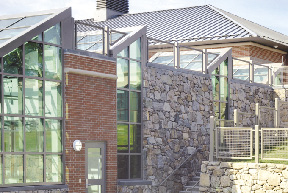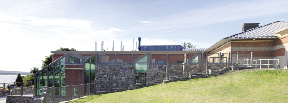D.F. Pray General Contractors, headquartered in Seekonk, Mass., has completed construction of the expansion research and educational facility at the Marine and Natural Science (MNS) Building at Roger Williams University. The project scope entailed the construction of a new building, which adjoins the university's existing MNS facility, and which houses the university's expanded shellfish hatchery and serves as a wet lab for research and educational studies.
The uniquely designed and engineered marine educational facility pipes in seawater from Mount Hope Bay via several 700-foot seawater pipes which were constructed and mounted on a concrete slab on a barge, then submerged into the Bay in 18 feet of water. Saltwater pumps and other related seawater piping equipment integral to the specially designed piping system were also tied into the system and placed in the Bay. The pipes were retrofit to the existing piping system for Roger Williams University's hatchery in the original MNS building, and the intricate underwater installation was provided by a professional diver. Within the seawater piping aspect of the project, filters on the existing pipes were replaced on intake lines.
D.F. Pray handled building construction to meet the university's class schedules, undertaking various aspects of the multi-dimensional project on weekend and after-hour schedules to accommodate student schedules and classroom studies. Classes remained fully operational throughout construction.
"Unexcavated ledge required D.F. Pray to undertake special underpinning techniques to bolster the existing foundation," according to the firm's project executive, Michael Carter. "D.F. Pray provided a soundly engineered underpinning resolution to the unforeseen condition of the ledge on which facility was constructed. The condition necessitated redesign of the foundation, an effort that was spearheaded and constructed by D.F. Pray to accommodate site topography," Carter said.
The facility integrates state-of-the-art mechanical, saltwater, and life safety systems, as well as a sophisticated sterilization system, which is integral to the laboratory facility. The facility's special air filtration and sterilization systems are designed to achieve optimal growing conditions, both for the facility's greenhouse and the shellfish hatchery. All piping and related equipment within the facility is non-corrosive (PVC and stainless steel) to withstand the harsh effects of saltwater. The wet lab is equipped with an epoxy floor.
Sustainability initiatives achieved through the facility's design include a green roof with eight skylights that enhance lighting and lighting efficiencies for the facility. Special lightning protection has also been integrated to the roof design. The greenhouse is also integral to the stone and glass façade marine science building design, as it is used to grow plankton for the hatchery.
Commenting on the project, Scott Pray, president of D.F. Pray, said "We are proud to have played a key role in the construction of this dynamic facility. It is a successful construction project and a high quality marine science facility for Roger Williams University and the scientific community. The university's project team and a cadre of diligent, highly qualified subcontractors were instrumental to its success. To construct a facility that will have far-reaching benefits for Roger Williams University, its students, the marine research communities, the commercial fishing industry in Rhode Island, and concurrently to help the ecological conditions of Mt. Hope Bay and Narragansett Bay is very gratifying for D.F. Pray."











